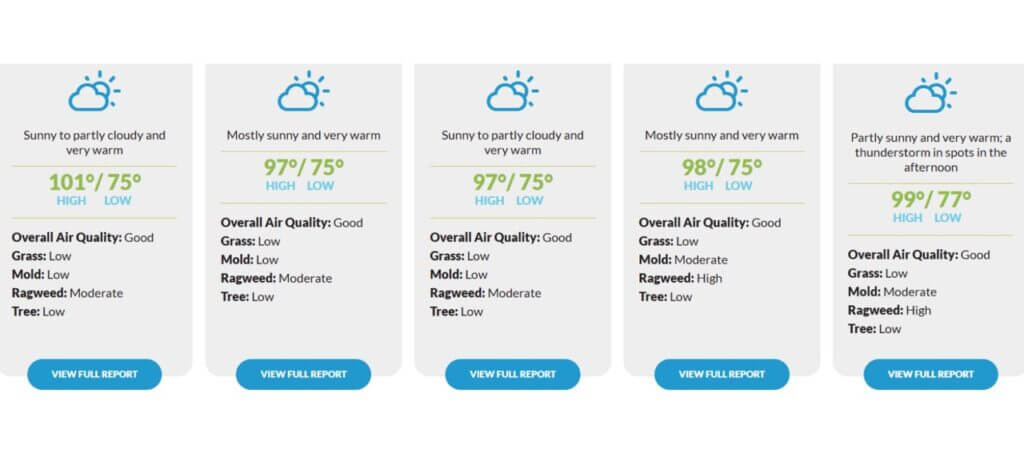August 20, 2025
Climate Change Allergies: How Climate Change Is Making Your Texas Allergies Worse and What Austin Patients Need to Know

If it feels like Austin’s allergy season just… never ends, you’re not imagining it. Over the past few decades, allergy seasons in Texas have been quietly stretching longer and hitting harder. Why? Climate change is reshaping when plants bloom, how much pollen they release, and how long you’re exposed to it.
To understand the impact, it’s important to know the most common allergens in Texas that drive these seasonal symptoms.
According to Climate Central, freeze-free seasons in Southwest cities are now more than 20 days longer than they were just a few decades ago. That’s nearly three extra weeks of pollen-filled air every year—right here in Central Texas.
If you’re one of the thousands of Austinites who battle cedar fever, oak pollen, ragweed, or mold, that’s a big deal. In this post, we’ll break down why climate change is fueling your allergies, which allergens are most affected, and—most importantly—what you can do to get ahead of it.
How Climate Change Extends Allergy Seasons in Texas
Warmer weather, earlier springs, and later falls aren’t just nice for patio brunch season—they’re also ideal conditions for plants to pump out more pollen. Here’s how it works:
As temperatures rise and seasons lengthen, plants produce more pollen, leading to higher pollen counts in the air. Pollen count is a key measure used to track the amount of pollen present, which helps allergy sufferers understand their risk and prepare accordingly. Climate change is also causing higher allergen levels overall, intensifying allergy and asthma symptoms for many people.
Longer Growing Seasons = More Pollen
When the first frost comes later in the year and the last frost arrives earlier in spring, plants get a much longer window to grow, bloom, and reproduce, allowing them to release large amounts of pollen. That extra time means large amounts of pollen are present in the air and a longer period you have to manage symptoms.
Warmer Temperatures and Higher CO₂ Levels
Rising carbon dioxide levels don’t just fuel climate change—they also act like plant fertilizer. More CO₂ means many plants produce larger amounts of pollen, and research shows that pollen can become more allergenic (more likely to trigger your symptoms) in these conditions, which can trigger allergic reactions in sensitive individuals.
Changing Weather Patterns
Heavier rainfall creates perfect breeding grounds for mold spores, and a humid climate further exacerbates mold and allergy problems by providing ideal conditions for mold growth and prolonging allergy symptoms. Milder winters encourage earlier budding in trees and grasses, kicking allergy season into gear before you’re ready.
Austin Allergy Season: Then vs. Now
In Austin, allergy season used to have clearer “start” and “stop” dates. Cedar pollen spiked in the winter, oak pollen ruled spring, ragweed dominated late summer and fall, and mold had its moments after heavy rain.
Now? These seasons are starting earlier, lasting longer, and overlapping. Pollen levels are now higher and more persistent throughout the year. That means your “break” from allergies is shorter—or in some cases, nonexistent.
For example:
- Mountain cedar is now releasing pollen earlier in December and lingering well into February.
- Oak season stretches deep into May instead of wrapping up in April.
- Ragweed season—already a beast—can now last into November.
- Mold spores pop up year-round whenever rain and humidity align.
The result: more weeks each year when your immune system is on high alert.
Allergy patterns and pollen levels can also vary significantly across different regions of Texas.
Texas Allergens Most Affected by Climate Change
Here’s a closer look at the common allergens most affected by climate change in Texas, which are the biggest troublemakers for Austin allergy sufferers. Identifying your specific allergens is crucial for effective allergy management and developing a personalized treatment plan. Increased exposure to these allergens can contribute to the development or worsening of allergic disease.
Mountain Cedar (Ashe Juniper)
- Loves mild winters and thrives in Central Texas’ hill country. Cedar trees are a major source of winter allergies in the region, as their pollen is highly prevalent during this season.
- Peaks in winter, but warmer weather extends the pollen window.
Ragweed
- Common in late summer and fall, but now sticking around longer. Ragweed pollen is a major allergen in Texas, causing significant allergy symptoms during this extended season.
- CO₂-rich air boosts both the amount and potency of its pollen. Ragweed plants are spreading to new regions and producing more pollen due to climate change, increasing allergy risks.
Oak & Tree Pollens
- Oaks, oak trees, elms, pecans, ash, and ash trees release pollen earlier in spring.
- Season overlap with grasses means more double exposure days.
Grass Pollens
- Bermuda, Johnson, and Timothy grasses emerge earlier in warm years. Weeds such as ragweed and Baccharis also contribute significantly to pollen levels during allergy season.
- Increased rainfall encourages thicker growth (and more pollen).
Mold Spores
- Warm, wet weather fuels mold in soil, leaves, and indoor spaces.
- Spikes after storms or flooding events, which are becoming more frequent.
The Health Impact on Austin Patients
For people with allergies or asthma, these changes aren’t just inconvenient—they’re a health concern. Longer exposure can mean:
- More frequent and intense allergic symptoms like sneezing, runny nose, congestion, itching, skin reactions, itchy eyes, and headaches.
- Increased risk of sinus infections from prolonged inflammation.
- More asthma flare-ups, especially in children and older adults.
- A higher need for medications or ongoing allergy treatments.
Over time, this can also take a toll on your energy, sleep quality, and even mental health.

How to Protect Yourself During a Longer Allergy Season
The good news: while you can’t control the climate, you can take steps to reduce your exposure and keep symptoms in check.
- Track Local Pollen Counts: Use our Daily Pollen Tracker to check pollen and mold levels in real time. If counts are high, you can plan to limit outdoor activities, keep windows closed, and adjust your allergy medications.
- Start Medications Early: Don’t wait until you’re miserable—start antihistamines or other prescribed treatments a couple of weeks before your allergy season begins. This helps reduce inflammation before it takes hold.
- Lifestyle Changes: Adopting lifestyle changes such as modifying your daily routines, adjusting your diet, and improving your home environment can help reduce allergy symptoms and support overall well-being.
- Reduce Exposure Indoors and Out:
- Change clothes and shower after being outdoors.
- Use HEPA air filters in your home, especially in bedrooms.
- Keep windows shut during peak pollen times.
- Consider Allergy Testing & Immunotherapy: If you’re unsure what’s triggering your symptoms—or you want a long-term solution—talk to your allergist about testing. Immunotherapy (allergy shots or drops) can help build your tolerance and reduce symptoms over time. Effective treatment may include a combination of medications, immunotherapy, and lifestyle changes.
- Manage Mold Risk: Fix leaks promptly, use dehumidifiers in damp spaces, and clean areas where mold may grow, like bathrooms and kitchens.
- Balloon Sinuplasty: For those with chronic sinus issues related to allergies, balloon sinuplasty is a minimally invasive procedure that can safely treat sinus congestion and improve breathing.

Why Now Is the Time to Take Action
Climate change isn’t a “future” problem—it’s already affecting the length, intensity, and frequency of Austin’s allergy seasons. And the trend is only heading in one direction.
That’s why proactive care matters:
- You can avoid weeks (or months) of discomfort.
- You’ll protect your respiratory health over the long term.
- You can enjoy more of what you love about Austin—outdoor concerts, hiking, patio dining—without worrying about constant sneezing and congestion.

Don’t Let a Longer Season Control You
Here’s the bottom line: Austin’s allergy season is getting longer and stronger because of climate change—but you’re not powerless. By understanding what’s changing, taking steps to protect yourself, and working with your allergist, you can stay ahead of the season and breathe easier.
Book your appointment with Greater Austin Allergy today and get a plan in place before your symptoms peak. Relief starts with a strategy—and the sooner you start, the better you’ll feel.
